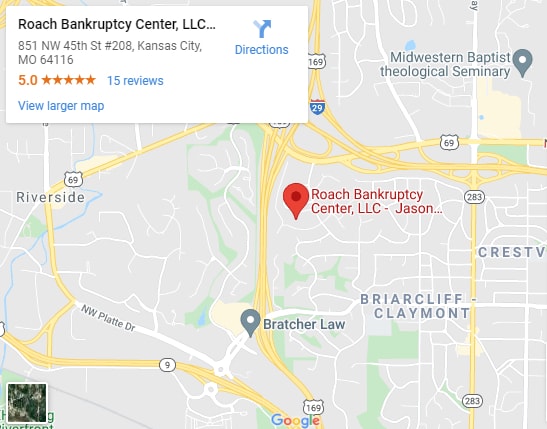Facing Bankruptcy and Student Loan Garnishment in Kansas City, MO – What Can You Do?
Are you trapped in an endless cycle of student loan garnishment, with hard-earned earnings being siphoned off to repay your educational debt? The burden of student loan garnishment can be overwhelming, leaving individuals struggling to make ends meet, and inhibiting their financial progress. However, there are ways to stop student loan garnishment in bankruptcy, providing a glimmer of hope amidst this financial turmoil.
In this blog, we will guide you through four workable solutions to stop the garnishment of your wages in Missouri and regain control of your financial future. Leveraging the legal avenues available through bankruptcy could be the decisive step toward your financial freedom and a fresh start.
At Roach Bankruptcy Center LLC, we aim to provide you with the best advice when it comes to ways to stop student loan garnishment in bankruptcy. Our bankruptcy lawyer is ready to give you your options. Ready to regain control of your financial future? Contact us today to explore your potential path to relief.
What are 4 Ways to Stop Student Loan Garnishment in Bankruptcy?
Garnishment of student loans can be a burden that weighs heavily on your financial well-being. However, there are viable strategies to combat this issue effectively. Below, we delve into four methods that could potentially halt student loan garnishment in the context of bankruptcy, starting with loan consolidation and rehabilitation. Each method has its own considerations and prerequisites, so understanding them is crucial for choosing the most appropriate route for your unique financial circumstance.
Method 1: Consider Loan Consolidation or Rehabilitation
If student loan garnishment is a concern, considering loan consolidation or rehabilitation could be an effective strategy. These programs, tailor-made for federal student loan borrowers, offer alternative repayment solutions that may alleviate garnishment stress and guide you toward financial stability.
What is Loan Consolidation?
Loan consolidation involves merging multiple student loans into a single new one. This process simplifies your repayment strategy and could also open the door to different repayment options, such as income-driven plans.
What Does Loan Rehabilitation Entail?
Loan rehabilitation is a unique process designed for borrowers who have defaulted on their federal student loans. It involves collaborating with your loan servicer to establish a repayment plan that aligns with your income.
Who Can Utilize Loan Consolidation and Rehabilitation: Key Criteria and Considerations
Deciding whether to pursue loan consolidation or rehabilitation depends on several factors. Let’s explore some of the key eligibility requirements and considerations for each:
- Loan Type – Consolidation and rehabilitation programs are primarily designed for federal student loans. Unfortunately, private student loans typically do not offer similar options.
- Current Loan Status – Consolidation is generally accessible to most federal student loan borrowers, while rehabilitation targets those who have defaulted on their federal student loans.
- Income – Both consolidation and rehabilitation programs take into account your current income, as this will largely dictate the repayment terms.
- Prior Default History – Loan rehabilitation is a one-time-only opportunity. If you’ve previously rehabilitated a loan, this option may not be available to you again.
- Long-Term Financial Goals – While both consolidation and rehabilitation can lower your monthly payments, they may also extend your repayment period and increase the total amount paid over the life of the loan.
Given these considerations, it’s crucial to seek advice from a bankruptcy attorney to make an informed decision. Contact Roach Bankruptcy Center LLC to help navigate your options and choose the right strategy for your financial situation.
Method 2: Proving Undue Hardship in Discharge
One of the most challenging yet potentially impactful methods for stopping student loan garnishment through bankruptcy is proving “undue hardship” for the discharge of student loans.
To successfully prove undue hardship, you typically need to meet the following criteria:
- Persistence – You must demonstrate that you have made a good-faith effort to repay your loans but are unable to maintain a minimal standard of living while doing so.
- Long-Term Hardship – You must show that your current financial situation is unlikely to improve significantly over an extended period. This requires establishing that the financial hardship is not temporary or transient but rather a persistent and lasting condition.
- Good Faith Effort – You must illustrate that you have made a diligent effort to repay your loans by exploring all available repayment options, modifying payments, and utilizing any available assistance programs.
While the criteria for demonstrating undue hardship vary among jurisdictions, the overarching principle is that you must show that continuing to repay your student loans would impose an undue burden on your financial well-being.
Method 3: Negotiate a Settlement
When dealing with student loan garnishment, negotiating a settlement with your loan servicer or debt collection agency can be a viable option to stop garnishment and resolve your student loan debt. While settlement may not be available in all cases, it’s worth exploring as it can potentially provide a mutually beneficial resolution.
Assessing Feasibility
Before initiating negotiations, assess the feasibility of a settlement. Consider factors such as the amount of outstanding debt, your financial situation, and the willingness of your loan servicer or debt collector to negotiate.
Contact your Loan Servicer or Debt Collector
Initiate communication with your loan servicer or debt collector to express your willingness to negotiate a settlement. Explain your financial hardship and demonstrate your commitment to resolving the debt. Request information about potential settlement options, repayment terms, and any required documentation.
Negotiating a settlement offers the potential to stop student loan garnishment and achieve a more manageable resolution to your student loan debt. By assessing the feasibility, seeking professional assistance, and engaging in constructive negotiations, you can work towards resolving your debt burden and regaining control of your financial situation.
Method 4: Exploring Alternative Repayment Options
When faced with student loan garnishment, exploring alternative repayment options can be a proactive approach to stop garnishment and manage your student loan debt more effectively. By understanding the various repayment plans available, you can find a solution that aligns with your financial circumstances and provides relief from garnishment.
Income-Driven Repayment Plans
Income-driven repayment plans, offered for federal student loans, base your monthly payment amount on your income and family size. These plans include options such as Income-Based Repayment (IBR), Pay As You Earn (PAYE), Revised Pay As You Earn (REPAYE), and Income-Contingent Repayment (ICR).
By switching to an income-driven plan, you can potentially lower your monthly payment and make it more affordable, thereby stopping garnishment.
Extended Repayment
Extended repayment plans extend the repayment period beyond the standard ten-year term, allowing you to stretch out your payments over a longer period. This can result in reduced monthly payments, making it more manageable to meet your financial obligations and potentially halt garnishment.
Loan Forgiveness Programs
Certain loan forgiveness programs, such as Public Service Loan Forgiveness (PSLF) and Teacher Loan Forgiveness, offer relief to borrowers who work in specific fields or meet specific criteria. By qualifying for these programs, you may be eligible for loan forgiveness after a certain number of qualifying payments.
Loan Refinancing
Loan refinancing involves replacing your current student loans with a new loan from a private lender. By refinancing, you may be able to secure a lower interest rate and better repayment terms. However, refinancing federal student loans with a private lender means forfeiting federal loan benefits, such as income-driven repayment plans and forgiveness options.
Bankruptcy and Its Role in Stopping Student Loan Garnishment
Bankruptcy, a legal procedure aimed at helping individuals and businesses grappling with insurmountable debt, can significantly influence the resolution of student loan garnishment issues. Though it’s crucial to underscore that completely discharging student loans via bankruptcy can be a complex process, bankruptcy nonetheless presents multiple strategies to stop or mitigate the impact of garnishment.
Which Types of Bankruptcy Can Address Student Loan Garnishment?
Bankruptcy generally falls into different chapters, with Chapter 7 and Chapter 13 being the most applicable for managing student loan garnishment.
Chapter 7 Bankruptcy
Often referred to as “liquidation” bankruptcy, Chapter 7 involves selling non-exempt assets to repay creditors. On filing for Chapter 7, an automatic stay comes into effect, temporarily pausing student loan garnishment and other collection efforts. While the complete discharge of student loans is seldom seen in Chapter 7, it can offer temporary respite and a chance to consider other alternatives.
Chapter 13 Bankruptcy
Known as “reorganization” bankruptcy, Chapter 13 establishes a three to five-year repayment plan to resolve debts. This approach can be advantageous for handling student loan garnishment. Besides the automatic stay halting immediate garnishment, Chapter 13 allows the inclusion of student loan payments within the structured repayment plan, making payments more manageable and potentially lessening overall financial stress.
Note that discharging student loans through bankruptcy demands a strict standard of “undue hardship”. Moreover, the nature of the student loan, such as federal or private, might impact the available options within bankruptcy proceedings.
In essence, understanding how bankruptcy plays a role in dealing with student loan garnishment paves the way to explore the four methods that can potentially halt or lessen this financial burden. While completely discharging student loans via bankruptcy can be challenging, the provided options can offer relief and an opportunity to regain control of your financial journey. Our Missouri bankruptcy attorney at Roach Bankruptcy Center LLC is committed to providing the clarity you need.
Contact our Bankruptcy Attorney in Kansas City, Missouri Now!
Confronting student loan garnishment and navigating the intricacies of bankruptcy can seem daunting, but you’re not alone. At Roach Bankruptcy Center LLC, we’re committed to helping you explore ways to stop student loan garnishment in bankruptcy.
Whether you’re considering establishing undue hardship, filing for Chapter 7 or 13 bankruptcy, or exploring alternative repayment strategies, our experienced team will guide you every step of the way with understanding and proficiency. Beyond student loan garnishment, we also offer legal solutions for challenges like divorce law, stopping repossession, and emergency bankruptcy filing.
Don’t wait another day to reclaim your financial future. Contact us now and let us guide you through the ways to stop student loan garnishment in bankruptcy.



